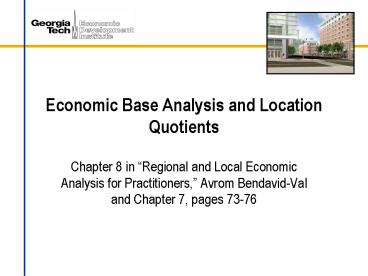Economic Base Analysis and Location Quotients - PowerPoint PPT Presentation
1 / 25
Title:
Economic Base Analysis and Location Quotients
Description:
Conduct a sample survey to measure the size of the flow of resources into and ... Employment used most often, but income or wages and salaries can also be used. ... – PowerPoint PPT presentation
Number of Views:721
Avg rating:3.0/5.0
Title: Economic Base Analysis and Location Quotients
1
Economic Base Analysis and Location Quotients
- Chapter 8 in Regional and Local Economic
Analysis for Practitioners, Avrom Bendavid-Val
and Chapter 7, pages 73-76
2
Definitions
- Basic Industry - Those industries that produce
goods and services ultimately sold to consumers
outside the region. - Non-basic Industry - Those industries that
produce goods and services that are consumed
locally. - Multiplier - Ratio of total economic activity to
basic economic activity.
3
Basic/Non-basic Theory
- A regions export industries are its economic
foundation, and all other industries thrive by
servicing the export industries and one another. - A change in the basic sector will lead
automatically to a change in the same direction
in the non-basic sector. - The ratio of non-basic to basic activity is
reasonably stable over the long term.
4
Geography Matters
- As you enlarge the region under study from a city
to a county .
5
Geography Matters
- And then to a multi-county area and finally to a
state, what is basic and what is non-basic can
change.
6
Basic/Non-basic Theory
- It follows that if a region can increase the
level of basic employment, it can increase total
employment by that amount times the multiplier.
7
Estimating Economic Base
- Judgmental approach
8
Judgmental Approach
- Analyst decides which industries are basic and
which are non-basic - Easy for some industries, hard for others
- Groceries and dentists surely local
- Printing company local paper vs. encyclopedias
9
Judgmental Approach
- Pros
- Easy to do from published data
- Cons
- The title alone states the primary problem
- Can vary from analyst to analyst
10
Estimating Economic Base
- Judgmental approach
- Survey method
11
Survey Method
- Conduct a sample survey to measure the size of
the flow of resources into and out of the region
in question. - Determine the share of output flowing outside the
region, for each company. - Use these shares with company employment (after
weighting) and sum across companies.
12
Survey Method
- Pros
- Derived from actual company-specific data in a
given region. - Cons
- High cost to administer.
- Very difficult to garner cooperation from firms.
- Sampling error to deal with.
13
Estimating Economic Base
- Judgmental approach
- Survey method
- Location Quotients
14
Location Quotients
- Statistic that measures the relative
concentration of a given industry in a given
place. - Calculated by dividing the proportion of the
areas economic activity in an industry by the
proportion of the nations economic activity, in
that same industry. - Employment used most often, but income or wages
and salaries can also be used.
15
Location Quotients
- eir employment in some industry (i) in some
region (r) - Seir total employment in the region
- Ei national employment in some industry (i)
- SEi total national employment
16
Location Quotient Example Calculation
Location Quotient (eir/Seir) / (Ei/SEi)
Location Quotient (.012676 / .004813) 2.63
17
Location Quotient Assumptions
- Patterns of consumption do not vary
geographically. - Labor productivity does not vary geographically.
- No cross-hauling simultaneous importing and
exporting of a product in a region. - No international trade exports from the
benchmark region (U.S.) distort location quotients
18
Location Quotient Values
- Location quotient 1
- Local production can just satisfy local
consumption. - Location quotient gt 1
- Local production can satisfy local consumption,
and the excess is exported. This is a basic
industry. - Location quotient lt 1
- Local production can not satisfy local
consumption, and the difference must be imported.
19
Location Quotient
- Not all of a basic industry is basic.
- Only that part of the industry that serves the
export market is considered basic. - It is that part of the industry that raises the
location quotient above 1.0
20
Using Location Quotients to Estimate Basic
Employment
- The location quotient equation can be used to
estimate basic and non-basic employment.
1. (eir / ?eir ) / (Eir / ? Eir ) 1.0 2. (eir
/ ?eir ) (Eir / ? Eir ) 3. eir (Eir / ? Eir
) ?eir (See page 80 in textbook) Where eir in
this equation is non-basic employment and basic
employment is actual minus non-basic employment.
21
Calculating Basic Employment Using Location
Quotients
Location Quotient (.011269 / .000506) 22.3
Non-basic Employment (.000506) 3,146,681
1,592
Basic Employment 35,461 1,592 33,869
22
Location Quotients
- Pros
- Easy to use simple calculations.
- Allows estimation of the basic sector without
direct observation of the inter-industry flow of
goods. - Employment data are easy to obtain.
- Cons
- Resulting basic employment is often biased
downward (because of cross-hauling problem) and
tends to show extremes at the local level.
23
Estimating Economic Base
- Judgmental approach
- Survey method
- Location Quotients
- Minimum Requirements
24
Minimum Requirements
- A variation on the Location Quotient approach.
- Uses the minimum industry employment ratio
(E(i)/E) among all regions instead of the U.S.
industry ratio. - Not used in practice. An example can be found at
http//garnet.acns.fsu.edu/tchapin/urp5261/topics
/econbase/min-req.htm
25
Location Quotients
- eir employment in some industry (i) in some
region (r) - Seir total employment in the region
- Ei national employment in some industry (i)
- SEi total national employment































